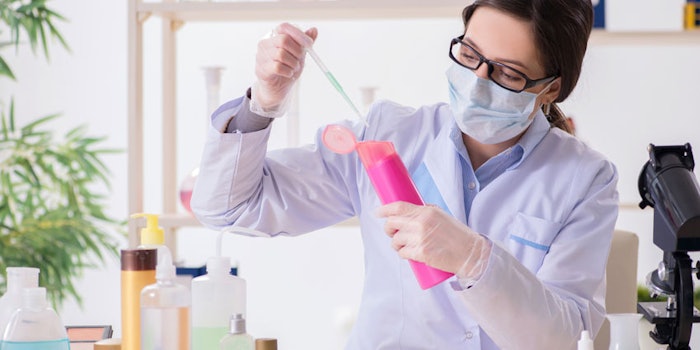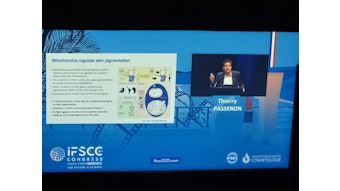
Programmable biology and fermentation are the future for beauty, according to Alexander Lorestani, CEO and founder of Geltor. He presented the Henry Maso keynote lecture during the 2019 SCC Annual Meeting. Sponsored by Siltech LLC, this honor recognizes outstanding research and achievements in cosmetic science.
"Science is the key driver of innovation in beauty but generally speaking, cosmetics is only at the tip of the trend," said Lorestani, who noted the vast potential of biology that lies ahead. He took attendees through a brief history of cosmetic innovation, whereby the industrial revolution enabled soapmaking via a semi-automated process.
"One hundred years later, after the industrial revolution, was the chemistry revolution—and the legacy of some of these entrepreneurs, such as Colgate-Palmolive, are still alive."
Biology Revolution
Now, we're in the biology revolution, according to Lorestani. "This is fundamental to what we do in cosmetic chemistry but we’re able to do so much more with it, now, and brands are evolving to adapt biology into products." He continued, "Biology became programmable around 2010 and DNA biosynthesis became possible; plus, the cost of reading DNA has dropped...but now, it’s [really] about the capability to write DNA . . .that has changed dramatically."
He added that by writing DNA, scientists powder fundamental capabilities and can build around biology by applying basic engineering principles to life itself. "The ability to design, build and test things around life as an actual platform is what’s really exciting about what’s possible today; and at the core of this is fermentation."
See related: Fermentation Cosmetics, Bubbling Over with Innovation, Literally
Lorestani noted that today, researchers can use processes that previously took a very long time to solve product development challenges. For example, one of the biggest challenges for cosmetics, particularly those that are natural, is to ensure high purity of raw materials. Another is efficiency, and while previous biological methods could engineer microbes to output various proteins, the developer still had to pull the desired entity from the mix. "However, designing a protein to only produce the desired protein is now possible thanks to the tools of DNA synthesis," said Lorestani; in this case, solving both purity and efficiency challenges.
'Look across the biology of life as a substrate for
what’s possible.'
"Fermentation is super important to everything that we’re doing here," he added. "Hyaluronic acid from roosters or squalene from sharks are not great sources. Also, butylene glycol from petroleum sources...you can now program biology to output [all] these materials." The biggest hurdle to these innovations, according to Lorestani, was merely imaging where the synthesis of these materials could be carried out in new ways.
Ethics and Sustainability
Clearly, writing DNA may raise the flag over ethics; but as Lorestani observes, these techniques offer truly sustainable solutions that society is ready to embrace. "It’s fascinating to see, [over the past] 100 years, the interception of new technologies and change in society norms shifting the way products make it to market."
He noted how consumers have come to realize the ethics of sourcing. "In a world [demanding] plant-based materials, natural does not [always] equal good...the practice of extracting palm oil, for example, is not sustainable. So thinking about how to use fermentation instead is an exciting opportunity."
Thinking Boldly
How and what else might science unlock with the biological toolkit? "Think boldly," Lorestani recommends, adding "look across the biology of life as a substrate for what’s possible." He gave collagen as an example, which ties into recent work by Geltor and partnering company Gelita to developing an ingestible, animal-free/vegan collagen for nutricosmetic applications.
"Collagen is present in every animal. [Typically, we derived it] from pigs, cows...etc. But what else is in the tree of life ... [that might produce it]?" The company leveraged a proprietary fermentation technology to create the ingredient HumaColl21, a biodesigned human collagen that according to the company website, boosts collagen production in fibroblasts and up-regulates the native production of more than 12 collagen types.
Lorestani believes that thinking across the tree of life "builds the broader imagination of the palette we have available to build from." He added that biology also inspires researchers to look at proteins that have not existed before. "If you can imagine the function you want, you can build a protein to fulfill that desired result. [Today's innovations allow you to] plug those parameters into a computer loaded with [background] data to create a new protein. These techniques are being employed today to bring new materials to market."
'For me as a scientist, besides the ethics, the efficacy [of biological innovation] is exciting.'
Future Consumers
Wrapping up the lecture, Lorestani predicted future the mindset of consumers. "As we look at how consumers ... are changing, they are seeing information about what’s in the bottle more than ever before. They see the nature of the ingredients they are bringing into their homes ... they know more about what’s in products."
He added, "Something else to think about, as we look at building a global network, is that consumers want to know about the greenhouse emissions produced." For example, Lorestani noted the number of kilograms of CO2 emitted through biologically derived processes such as fermentation is just seven, whereas it is more like 30 kg+ for actual animal-derived production.
"For me as a scientist, besides the ethics, the efficacy [of biological innovation] is exciting," said Lorestani. "When you bring a level of rigor that’s used in pharma, you can validate and recreate the efficacy. This matters because, again, consumers think more and differently about the ways things are produced.
"So what’s next?" he posited. "There are lots of questions about how consumers will react to these tech platforms. Also, how will [these platforms] interact with and complement existing systems? We don’t know yet what the challenges will be," said Lorestani.
Ethics, Language and GMO Debate
Following his presentation, the Q&A session raised questions surrounding consumer concerns over genetically modified organisms (GMOs). Lorestani responded by separating the process from the end product.
"I think broadly, we see a separation between processes and products," he said. "GMOs can be used to process but the end ingredient is not a GMO. You can say there is no GMO in the end product. We see a trend in that direction globally [from certifying agencies and other organizations], although it will vary. There are also some markets where it’s less of an issue."
In relation, one audience member noted how a common thread in the presentation was ethics. "Are we at a point where we post-design ethics?" he asked. "For example, with clean and trusted ingredients? How can we move to more subjective definitions between groups to get a better consensus or understanding?"
Lorestani responded, "We can define codes of ethics ... Developing a shared language will be an important part of the process. It’s something that ultimately is based off of how our industry is acting in the world around us. 'Clean' beauty, 'natural,' etc., are areas that we don’t have a shared language around—and and I’m for building a shared language for what that means. The human drive, that innate drive asking 'what does that mean?' etc., requires a shared language."
'Developing a shared language will be an important part of the process. It’s something that ultimately is based off of how our industry is acting in the world around us.'
Another attendee disagreed with Lorestani's separation of process vs. product under the non-GMO label. "With all due respect, we should stop fooling ourselves," he said. "I think if we are modifying organisms to produce products, those end products are GMO—this is really not a question but a comment."
Lorestani replied, "I think we need to hear all these conversations and work to build a common language. It’s a critical part of the conversation to build the future of this area."
The discussion continued, "[I believe] our industry will not be able to move to a GMO-free concern in the future, and we need to be able to live with it," the attendee scrutinized.
To which Lorestani resolved, "I think we need to look at the full picture including the good, bad and ugly of the past and learn from it. I agree with you and I think we need to make sure we’re working together to build the future direction."






!['We believe [Byome Derma] will redefine how products are tested, recommended and marketed, moving the industry away from intuition or influence, toward evidence-based personalization.' Pictured: Byome Labs Team](https://img.cosmeticsandtoiletries.com/mindful/allured/workspaces/default/uploads/2025/08/byome-labs-group-photo.AKivj2669s.jpg?auto=format%2Ccompress&crop=focalpoint&fit=crop&fp-x=0.49&fp-y=0.5&fp-z=1&h=191&q=70&w=340)



